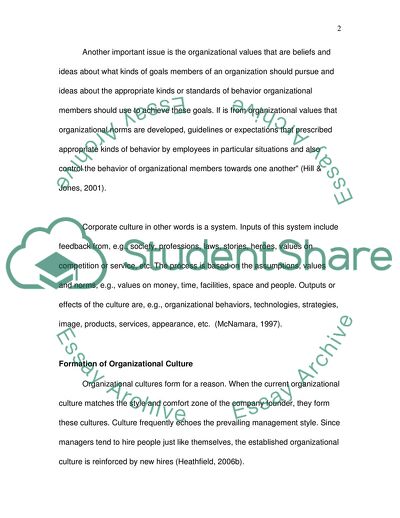
- Home
- Free Samples
- Premium Essays
- Editing Services
- Extra Tools
- Essay Writing Help
- About Us
- Studentshare
- Subjects
- Miscellaneous
- How is the organizatinal culture formed and continued in the future
How is the organizatinal culture formed and continued in the future - Essay Example

- Subject: Miscellaneous
- Type: Essay
- Level: Masters
- Pages: 4 (1000 words)
- Downloads: 0
- Author: padbergvanessa
Extract of sample "How is the organizatinal culture formed and continued in the future"
Edgar Schein, one of the most prominent theorists of organizational culture, gave the following very general definition: The culture of a group can now be defined as: A pattern of shared basic assumptions that the group learned as it solved its problems of external adaptation and internal integration, that has worked well enough to be considered valid and therefore, to be taught to new members as the correct way to perceive, think, and feel in relation to those problems (Schein 373-374). Another important issue is the organizational values that are beliefs and ideas about what kinds of goals members of an organization should pursue and ideas about the appropriate kinds or standards of behavior organizational members should use to achieve these goals.
If is from organizational values that organizational norms are developed, guidelines or expectations that prescribed appropriate kinds of behavior by employees in particular situations and also control the behavior of organizational members towards one another" (Hill & Jones, 2001). Corporate culture in other words is a system. Inputs of this system include feedback from, e.g., society, professions, laws, stories, heroes, values on competition or service, etc. The process is based on the assumptions, values and norms, e.g., values on money, time, facilities, space and people.
Outputs or effects of the culture are, e.g., organizational behaviors, technologies, strategies, image, products, services, appearance, etc. (McNamara, 1997). Organizational cultures form for a reason. When the current organizational culture matches the style and comfort zone of the company founder, they form these cultures. Culture frequently echoes the prevailing management style. Since managers tend to hire people just like themselves, the established organizational culture is reinforced by new hires
...Download file to see next pages Read MoreCHECK THESE SAMPLES OF How is the organizatinal culture formed and continued in the future
Situational Awareness of Shared Leadership in a Self-Managing Team
Organizational Culture Profile
Corporate Culture-Financial Performance Relationship in Multinational Corporations
Validity of Hofstede's Work-Related Values within Jordanian Culture
Cross Cultural Alliances
Influence of Diverse Culture on Change
Role of Organizational Culture in Change management
Changing the Organisational Culture: from Command-and-Control to Learning Organisation

- TERMS & CONDITIONS
- PRIVACY POLICY
- COOKIES POLICY